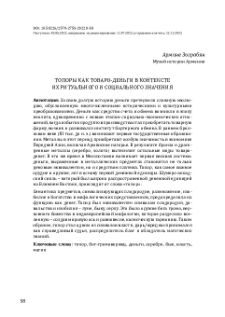Օբյեկտ
Վերնագիր: Топоры как товаро-деньги в контексте их ритуального и социального значения
Ամսագրի կամ հրապարակման վերնագիր:
Հրապարակման ամսաթիվ:
Հատոր:
ISSN:
Պաշտոնական URL:
Լրացուցիչ տեղեկություն:
Այլ վերնագիր:
Axes as commodity-money in the context Of their ritual and social significance
Աջակից(ներ):
Ծածկույթ:
Ամփոփում:
During its history, money has undergone a complex evolution due to historical and cultural transformations in the different periods. Money as medium of account and exchange arose in the Neolithic era simultaneously with the new stage of social-economic relations, when the surplus of products takes on a commodity form and the barter exchange developed. In the Early Bronze Age (III millennium BC) the first statements arose, bronze and precious metals appeared in Western Asia including the Armenian Highland. At the same time measurement of weight was created in Mesopotamia, money expressed in metal objects became not only a price equivalent, but also medium of payment. The axe, as the most important tool and weapon, acquires the significance of money. Therefore, the Sumer/Akkadian shekel, which was the widespread unit of currency in Near East, originates from the word “axe”.
Հրատարակության վայրը:
Москва-Ереван
Հրատարակիչ:
Институт языкознания РАН ; Институт археологии и этнографии НАН
Ձևաչափ:
Չափեր:
Նույնացուցիչ:
սեղմիր այստեղ կապին հետևելու համար ; oai:arar.sci.am:359404
Օբյեկտի հավաքածուներ:
Վերջին անգամ ձևափոխված:
Apr 15, 2024
Մեր գրադարանում է սկսած:
May 17, 2023
Օբյեկտի բովանդակության հարվածների քանակ:
119
Օբյեկտի բոլոր հասանելի տարբերակները:
https://arar.sci.am/publication/384863
Ցույց տուր նկարագրությունը RDF ձևաչափով:
Ցույց տուր նկարագրությունը OAI-PMH ձևաչափով։
-
Армянский гуманитарный вестник=Հայագիտական ուսումնասիրություններ. Պարբերագիր=Bulletin of Armenian Studies (Periodical Journal)
-
Армянский гуманитарный вестник, 2009, 2/3-I
-
Армянский гуманитарный вестник, 2009, 2/3-II
-
Армянский гуманитарный вестник, 2012, 4
-
Армянский гуманитарный вестник, 2021, 7
-
Армянский гуманитарный вестник, 2022, 8 (Специальный выпуск)
-
Армянский гуманитарный вестник, 2022, 9
- Обложка; Редакционная коллегия
- Оглавление
- Культовые памятники из некрополя Кармир Берд
- Эталонные матрицы мерных гирь из Шенгавита
- Арташат – Артаксата: Античный мега-полис в свете новейших археологических изысканий
- Топоры как товаро-деньги в контексте их ритуального и социального значения
- Практики тайных крещений в Советской Армении
- Святые места и досуг: На перекрестке сакрального и профанного (на примере современных религиозных практик Армении)
- «Национальное по содержанию и социалистическое по форме»: Палимпсест мемориалов Советской Армении
- К истории оливы в культуре Ирана
- Письмо Иштар-Шуму-Эреша - Асархаддону (abl 519 = las 13) в контексте прогнозирования внешней и внутренней политики Ассирии
- Франк (европеец) – персонаж армянского и тюркского эпосов
- Сюни-ванк, или церковь св. Григория (VII в.): Попытка нового прочтения скульптурных изображений
- The Attributes of Sacredness of Animals on the Reliefsof Armenia and Georgia (6th-14th Centuries)
- О новонайденном хачкаре из Сергиева Посада
- Требования к авторам
-
Армянский гуманитарный вестник, 2023, 10/1
-
Армянский гуманитарный вестник, 2023, 11/1 (Специальный выпуск)
-
Армянский гуманитарный вестник, 2023, 11/2 (Специальный выпуск)
-
Армянский гуманитарный вестник, 2009, 2/3-I
| Հրատարակության անուն | Ամսաթիվ |
|---|---|
| Зограбян, Армине, Топоры как товаро-деньги в контексте их ритуального и социального значения | Apr 15, 2024 |





